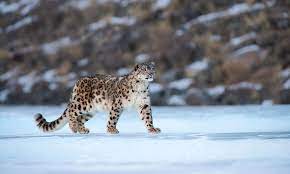Snow Leopard:

As per the study by the Zoological Survey of India, the Snow leopard regulates the population of its herbivores prey species (Siberian ibex and blue sheep)
- Snow leopard detection probability was high if the site was used by its prey species.
- Indicator species and flagship species: Snow leopards act as an indicator of the health of the mountain ecosystem in which they live, due to their position as the top predator in the food web.
- Threats: loss of natural prey species, retaliatory killing due to conflict with humans and illegal trade of its fur and bones.
- Habitat: Snow leopards use rugged mountainous areas or non-forested areas covering an altitude between 3200m-5200m
habitat covariates, such as barren area, grassland, aspect, slope and distance to water were important drivers of habitat use for the snow leopard as well as its prey species.
Conservation Effort:
- Global Snow Leopard and Ecosystem Protection (GSLEP) Programme (2013),
- HimalSanrakshak (community volunteer programme, 2020),
- SECURE Himalaya (GEF and UNDP funded programme),
- Project Snow Leopard (2009),
- 21 critically endangered species for the recovery programme (MoEFCC),
- Snow Leopard conservation breeding programme (at Padmaja Naidu Himalayan Zoological Park, Darjeeling)




